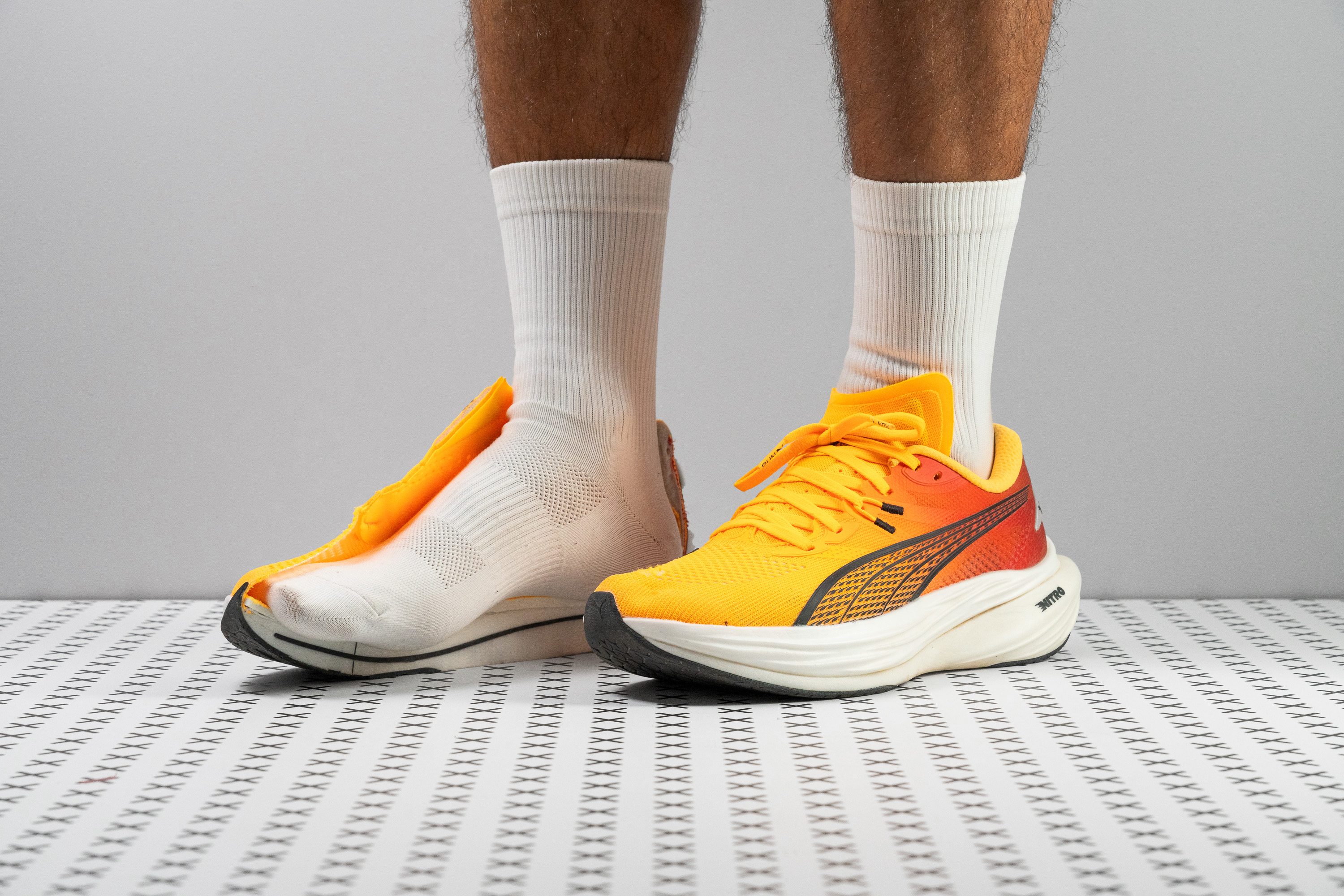Our verdict
- Top pick in best Running shoes for 5K and 10K races
- Top pick in best PUMA running shoes
Pros
- Exceptional grip on all surfaces
- Competitively priced
- Responsive carbon plate
- Adapts well to all paces
- Enhanced knit upper
- Ideal for tempo workouts
- Great at navigating tight turns
Cons
- Needs better energy return
- Minor increase in weight
- Ventilation could be better
- Narrow toebox
Audience verdict
- Top 29% in HYROX running shoes
- Top 15% most popular running shoes
Comparison
The most similar running shoes compared
+ + Add a shoe | |||||
|---|---|---|---|---|---|
| Audience score | 89 Great! | 92 Superb! | 90 Superb! | 92 Superb! | |
| Price | $160 | $170 | $230 | $170 | |
| Pace | Tempo | CompetitionTempo | CompetitionTempo | CompetitionTempo | |
| Shock absorption | High | High | High | High | |
| Energy return | Moderate | Moderate | High | Moderate | |
| Traction | High | High | High | Moderate | |
| Arch support | Neutral | Neutral | Neutral | Neutral | |
| Weight lab Weight brand | 9.5 oz / 268g 9.5 oz / 269g | 8.4 oz / 237g 8.5 oz / 242g | 7.2 oz / 204g 7.4 oz / 209g | 8.7 oz / 248g 8.6 oz / 244g | |
| Lightweight | ✗ | ✓ | ✓ | ✓ | |
| Drop lab Drop brand | 10.1 mm 10.0 mm | 9.6 mm 8.0 mm | 10.6 mm 8.0 mm | 9.6 mm 8.0 mm | |
| Strike pattern | Heel | HeelMid/forefoot | Heel | HeelMid/forefoot | |
| Size | Slightly small | True to size | True to size | True to size | |
| Midsole softness | Soft | Soft | Soft | Soft | |
| Difference in midsole softness in cold | Normal | Small | Normal | Small | |
| Toebox durability | Decent | Good | Bad | Good | |
| Heel padding durability | Decent | Good | Good | Good | |
| Outsole durability | Decent | Good | Decent | Good | |
| Breathability | Moderate | Breathable | Moderate | Moderate | |
| Width / fit | Narrow | Medium | Medium | Narrow | |
| Toebox width | Narrow | Medium | Narrow | Medium | |
| Stiffness | Stiff | Stiff | Stiff | Stiff | |
| Torsional rigidity | Stiff | Stiff | Stiff | Stiff | |
| Heel counter stiffness | Flexible | Flexible | Flexible | Stiff | |
| Plate | Carbon plate | Carbon plate | Carbon plate | Carbon plate | |
| Rocker | ✗ | ✓ | ✓ | ✓ | |
| Heel lab Heel brand | 37.4 mm 39.0 mm | 42.5 mm 43.5 mm | 39.2 mm 40.0 mm | 39.7 mm 40.0 mm | |
| Forefoot lab Forefoot brand | 27.3 mm 29.0 mm | 32.9 mm 35.5 mm | 28.6 mm 32.0 mm | 30.1 mm 32.0 mm | |
| Widths available | NormalWide | NormalWide | Normal | Normal | |
| Orthotic friendly | ✓ | ✓ | ✓ | ✓ | |
| Season | All seasons | SummerAll seasons | All seasons | All seasons | |
| Removable insole | ✓ | ✓ | ✓ | ✓ | |
| Ranking | #116 Top 31% | #19 Top 6% | #38 Top 11% | #12 Top 4% | |
| Popularity | #55 Top 15% | #61 Top 17% | #49 Top 14% | #28 Top 8% |
Who should buy
After extensively testing the eagerly anticipated Deviate Nitro 3 in our lab, we believe it's an excellent choice for:
- Runners looking for an affordable carbon-plated shoe suitable for both training and occasional races.
- Anyone looking for a versatile running shoe with exceptional traction.
- Heel strikers in search of a high-drop shoe that ensures smoother turnover without an ultra-rockered sole.
- Fans of the Deviate Nitro 2 who desired more cushioning for long runs—this update delivers just that.
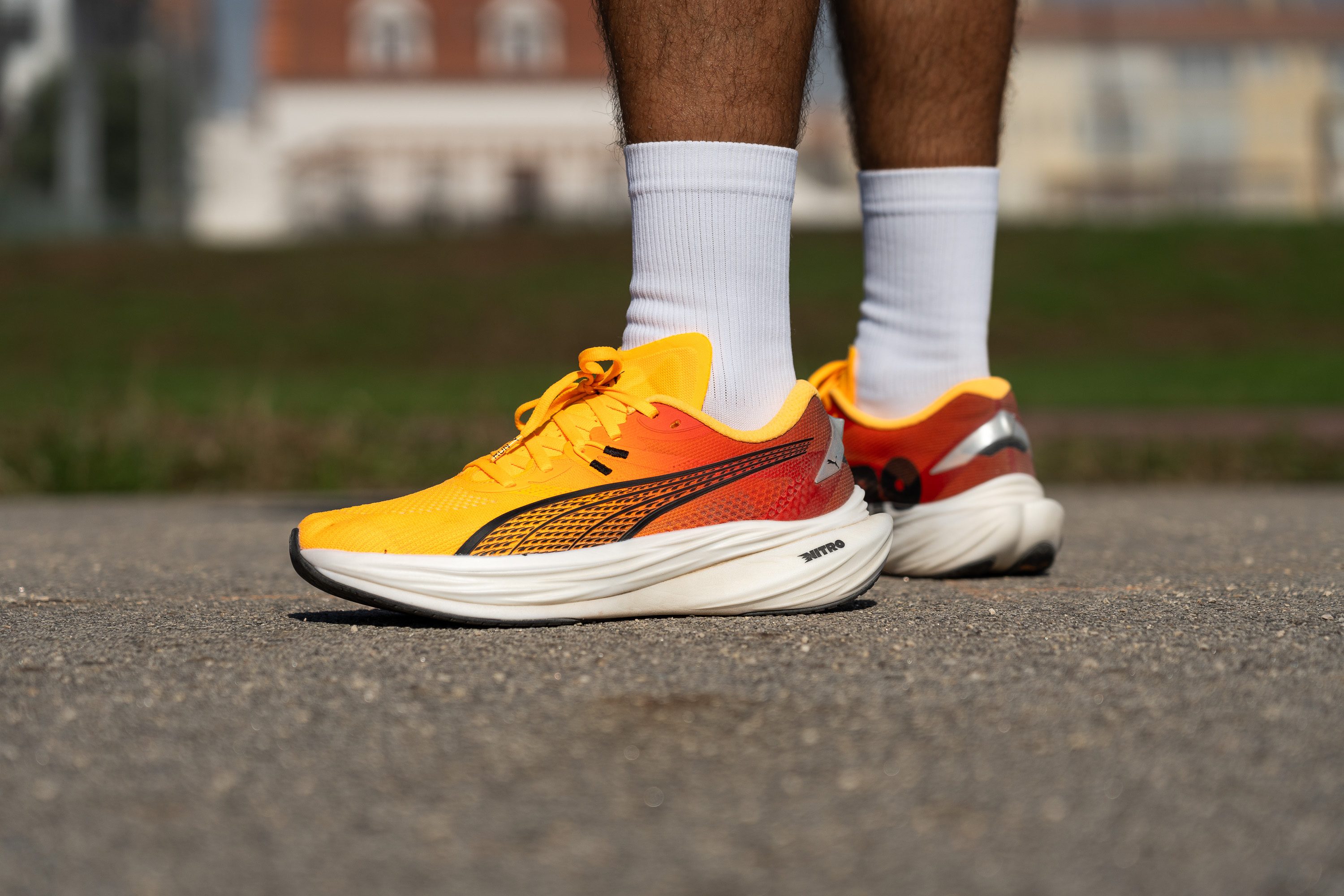
Who should NOT buy
We do not recommend the Deviate Nitro 3 for runners seeking stability, as its race-oriented design may not provide sufficient support, especially in the heel. For those discouraged by this problem, we suggest exploring alternatives like the ASICS Superblast 2 or the Saucony Endorphin Speed 4, both of which are lighter and way more stable.
Furthermore, in our testing, we found the Deviate Nitro 3 overly restrictive for anyone but those with narrow or average feet. For runners needing a roomier option, we recommend the On Cloudmonster Hyper, which provides a more accommodating upper and enhanced comfort for those with wide feet.
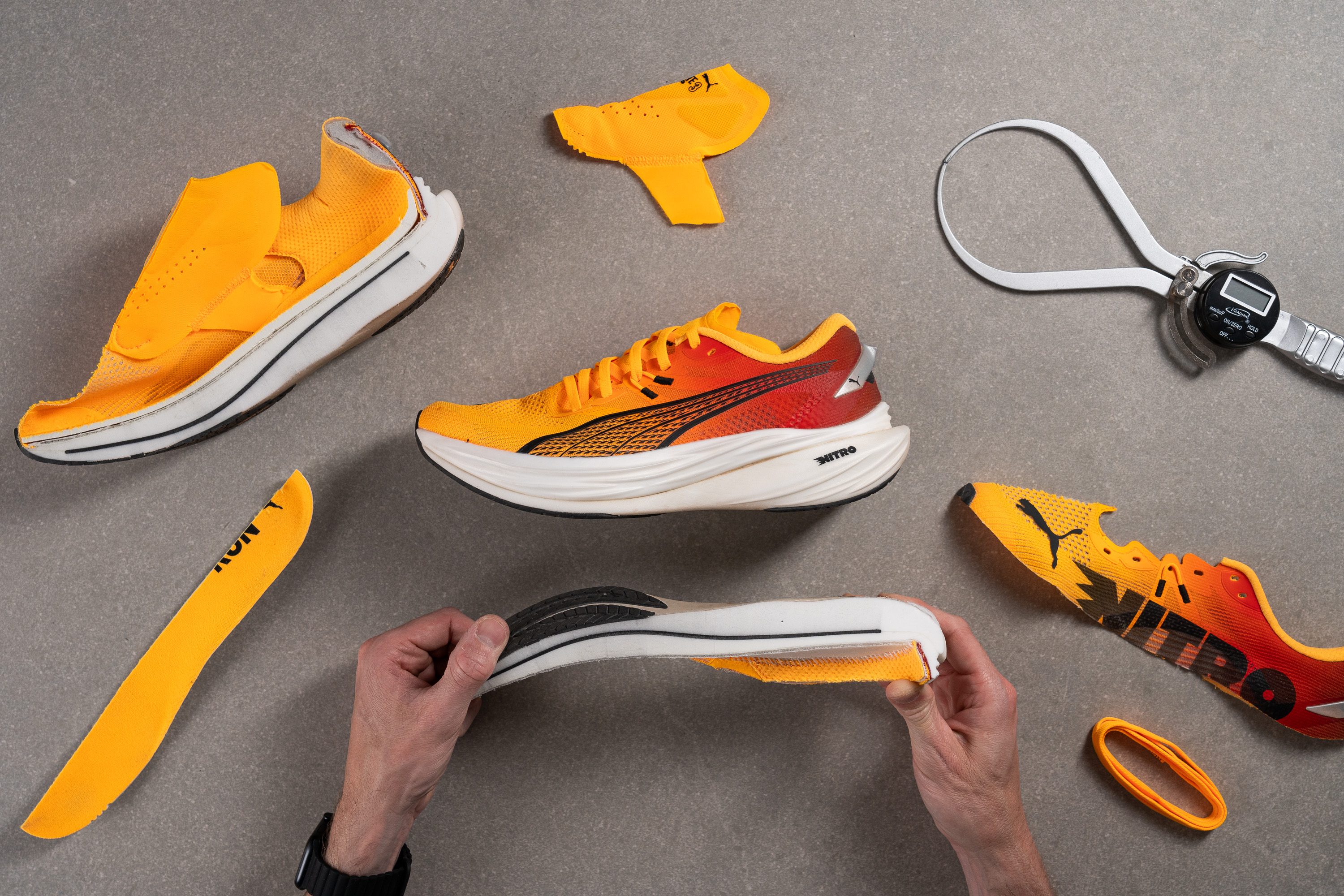
Cushioning
Shock absorption
PUMA added extra foam to this shoe compared to v2, and we noticed the difference in shock absorption. While it still hovers around the average, it provides slightly more underfoot protection with 132 SA.
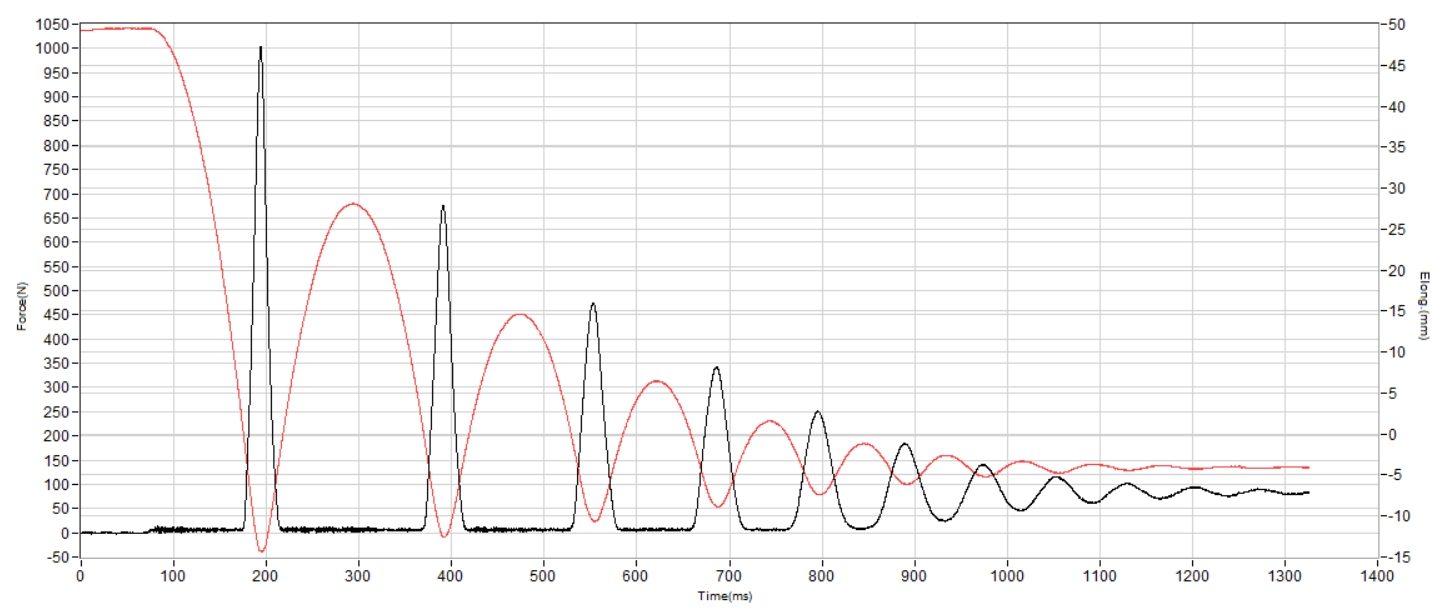
| Deviate Nitro 3 | 132 SA |
| Average | 129 SA |
Energy return
We asked for an improvement when we reviewed version 2, and PUMA somewhat delivered. While we found that 60.7% is clearly better than its predecessor, it still falls short of what we expect from a top-tier tempo trainer. It really needs to get closer to 70%.
| Deviate Nitro 3 | 60.7% |
| Average | 58.5% |
Heel stack
The most significant change in the Deviate Nitro 3 compared to the second version is the stack height. We measured a 5.7-mm increase from the DN2, reaching a substantial 37.4 mm. This higher stack is a blessing for rearfoot strikers, especially those with heavier builds.
We found that this minor weight increase is a worthwhile trade-off. In our view, the added cushioning more than compensates for the extra weight.

| Deviate Nitro 3 | 37.4 mm |
| Average | 34.8 mm |
Forefoot stack
The forefoot features 27.3 mm of stack, providing ample cushioning for midfoot and forefoot strikers to confidently take on long runs without any issue.
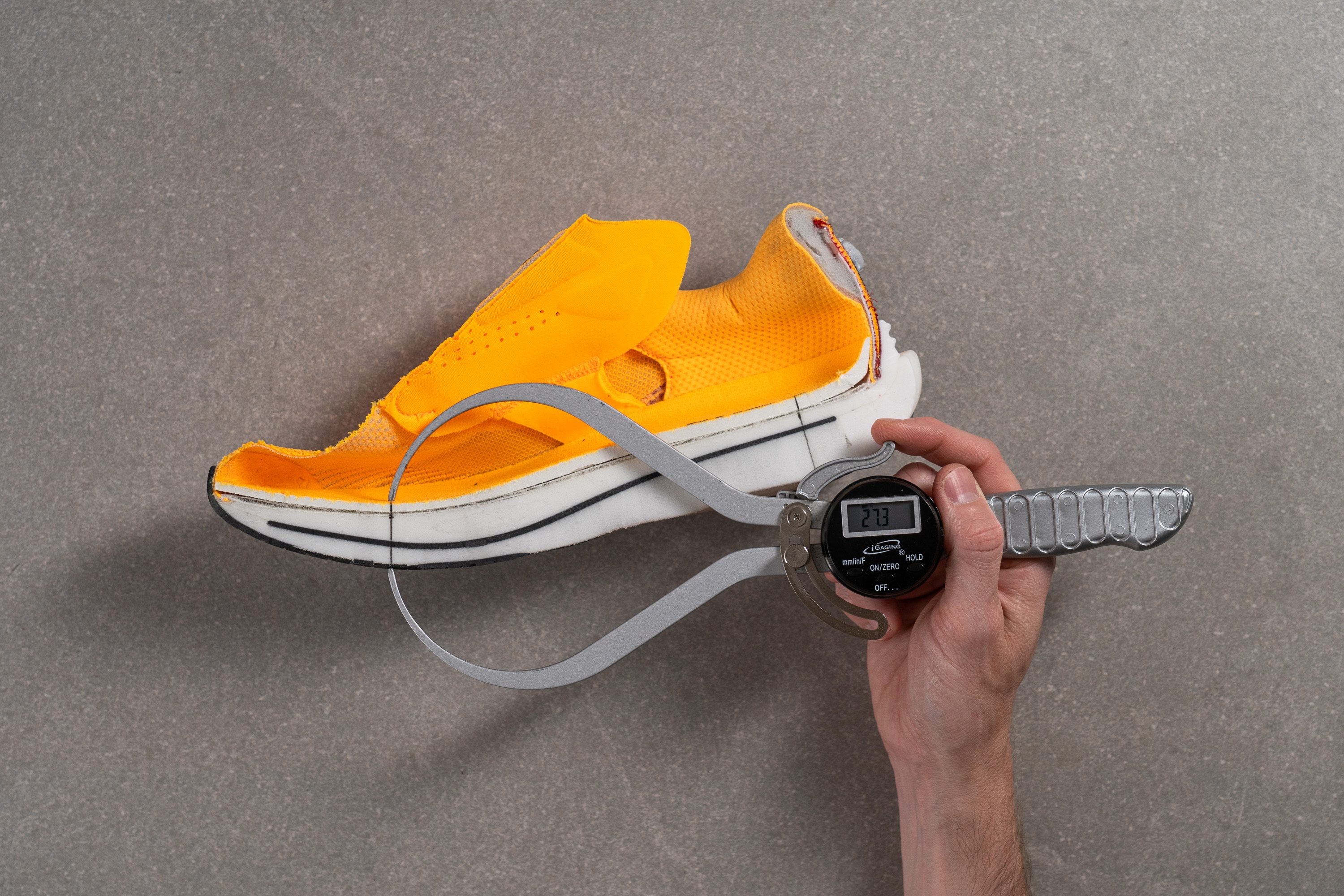
| Deviate Nitro 3 | 27.3 mm |
| Average | 26.2 mm |
Drop
After both measurements, we did the basic math and found a 10.1 mm drop—remarkably close to Puma's official 10 mm figure. It's rare that a brand's stated figure matches our lab results so closely!
But what does a 10 mm offset imply? We believe that this shoe is better suited for rearfoot strikers, yet it remains versatile for all runners. At the end of the day, this drop is similar to many daily running shoes like the PUMA Velocity Nitro 3.

| Deviate Nitro 3 | 10.1 mm |
| Average | 8.6 mm |
Midsole softness
The Deviate Nitro 3 maintains the same dual-foam formula as its predecessor, combining a bottom layer of Nitro with a top layer of Nitro Elite. Let's start with the former.
We discovered that Nitro, PUMA's go-to foam for training shoes, is still a winner. This nitrogen-infused foam significantly outperforms standard EVA, offering much better energy return.
In terms of softness, we measured it at 18.0 HA with our Shore A durometer, which is a balanced approach for a shoe debuting in 2024. It’s not ultra-plush, but definitely on the softer side, providing a comfortable and responsive ride.
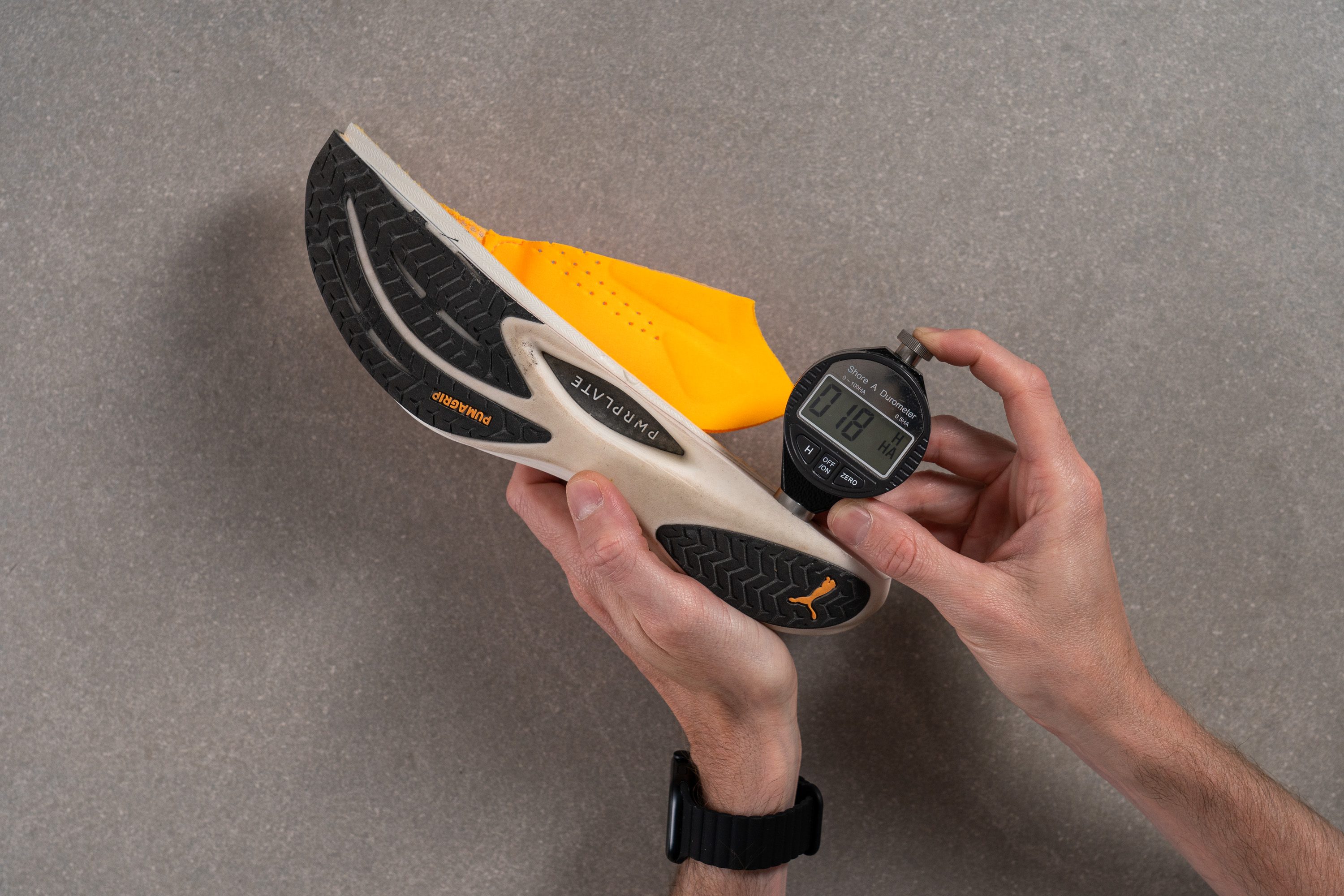
| Deviate Nitro 3 | 18.0 HA |
| Average | 20.4 HA |
Secondary foam softness
But the real gem of the shoe is above the plate: Nitro Elite. For some reason, PUMA does not brand this foam on the shoe, saving it for their top-tier models like the Deviate Nitro Elite 2 for marketing reasons. However, it’s definitely there, and we discovered it after slicing the shoe in half.
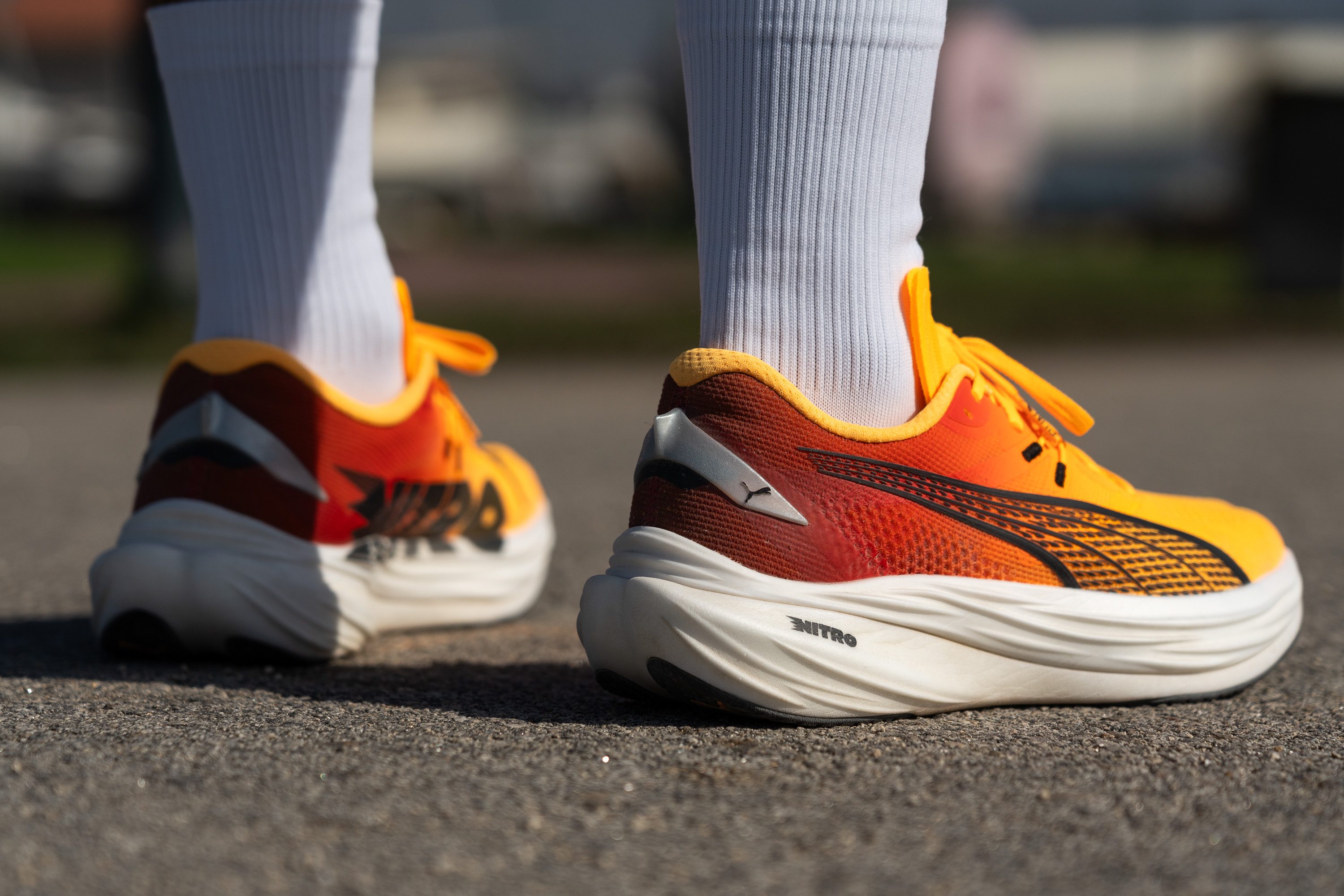
We found that Nitro Elite came in slightly firmer under our durometer at 19.0 HA, but the difference is barely noticeable.

| Deviate Nitro 3 | 19.0 HA |
| Average | 22.7 HA |
Rocker
As brands experiment with rockered designs, it's refreshing to find one that offers a more natural running experience.
We appreciated how the Deviate Nitro 3 maintains a somewhat traditional feel with its subtle rocker. It gently aids in turnover without being overly aggressive—a balanced approach we really liked!

Size and fit
Size
PUMA Deviate Nitro 3 fits slightly small (183 votes).
Width / Fit
While some runners hoped for a wider fit in the Deviate Nitro 3, we found that PUMA has continued with the narrow design of its previous model. And hey, we respect PUMA’s commitment to their design philosophy—if they believe in their idea, they stick with it.
We made a 1:1 gel replica of the Nitro 3's interiors and confirmed that it remains narrow, measuring only 91.5 mm at its widest part. This design is comparable to many racing shoes and is ideal for runners with narrow feet, offering a snug, race-ready fit. And for those who prefer a broader fit, we think that the New Balance Fuelcell Rebel v4 is an interesting alternative.
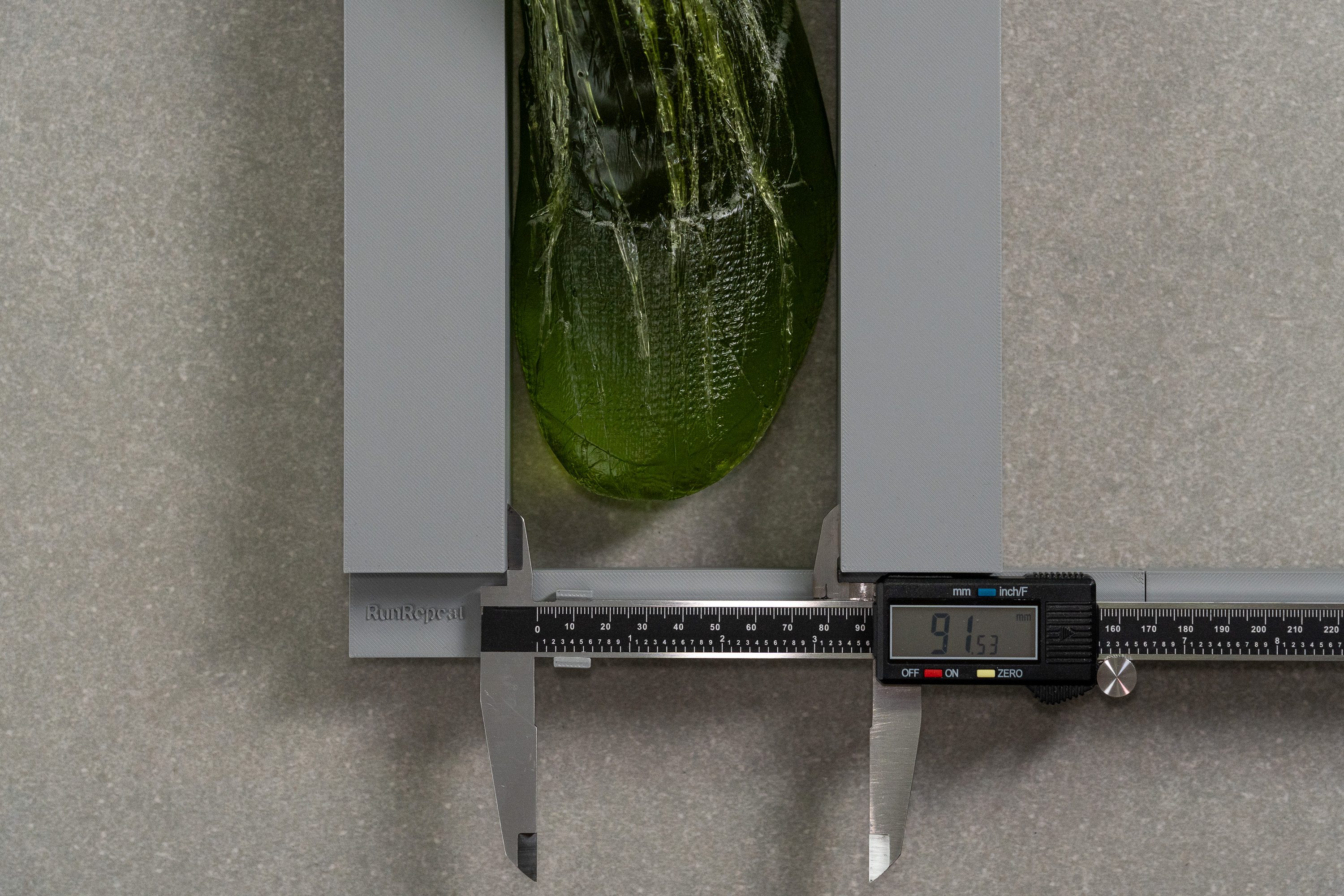
| Deviate Nitro 3 | 91.5 mm |
| Average | 95.1 mm |
Toebox width
The narrowness of the upper continues in the toebox, where our second measurement revealed only 69.7 mm.

This places it among the few shoes below the 70-mm threshold, making it best suited for narrow-footed runners.

| Deviate Nitro 3 | 69.7 mm |
| Average | 73.2 mm |
Toebox height
Those who enjoy a tight, race-focused fit will thrive in this shoe. The height of the upper is notably low, measuring just 24.6 mm.
However, if you prefer a bit of freedom inside the shoe, even sizing up won’t make a difference with the Deviate Nitro 3. Its snug fit is clearly built for speed rather than comfort.
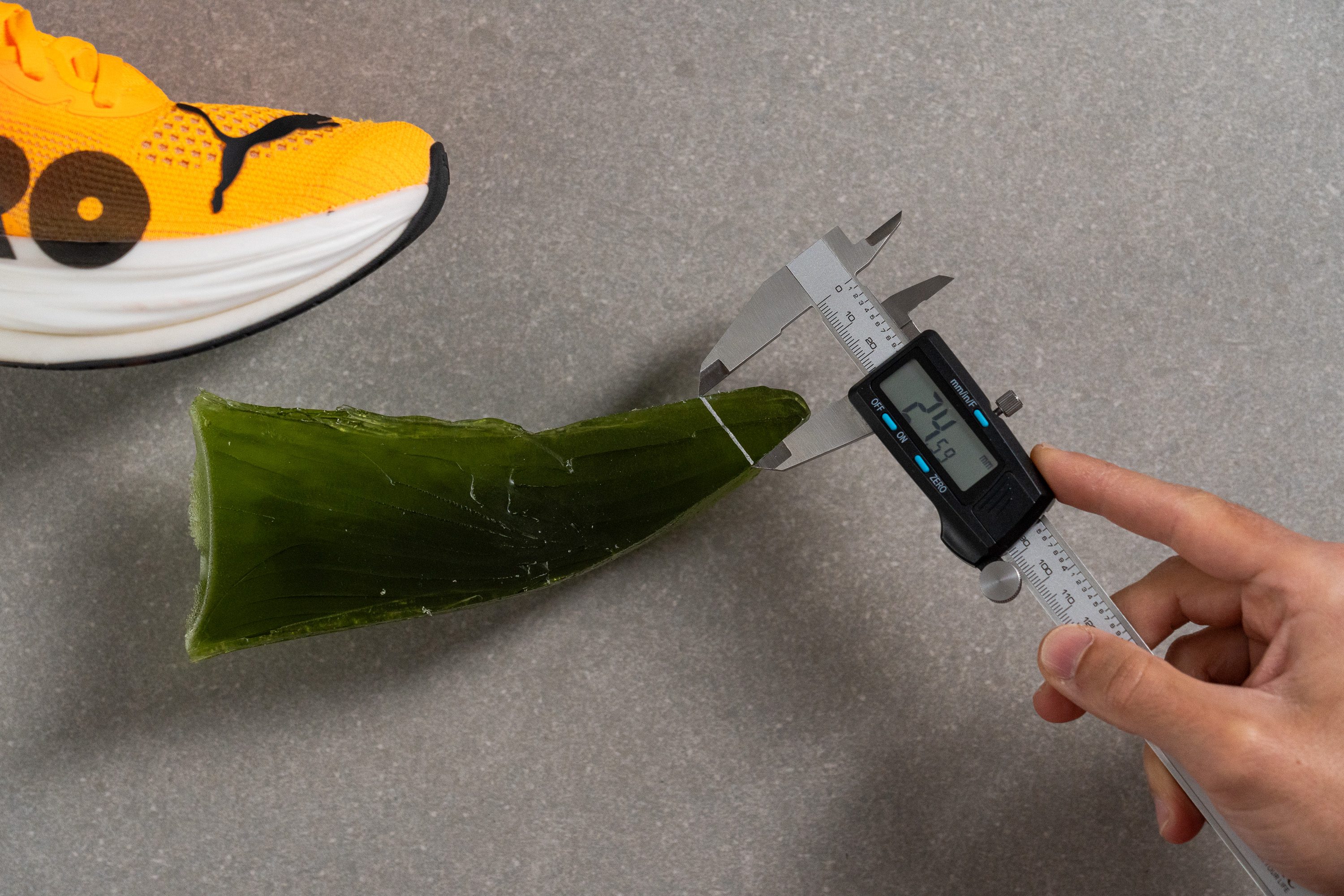
| Deviate Nitro 3 | 24.6 mm |
| Average | 27.1 mm |
Traction / Grip
Traction test
The PUMA Deviate Nitro 3 crushed it in our rainy-condition grip test with a standout 0.65 score—proof of great wet traction and superior grip on dry roads.
That kind of performance is no surprise given the PumaGrip rubber, often seen as one of the gold standards in the industry. Still, it’s satisfying to see that real-world rep backed by our lab-confirmed result!
| Deviate Nitro 3 | 0.65 |
| Average | 0.48 |
Outsole design
We already proved that with the Deviate Nitro 3, you can embrace any weather thanks to its exceptional grip. And we're also on board with performance-oriented running shoes featuring a bit more exposed midsole than a typical daily trainer.
On the negative side, we've observed that although it grips well on every surface, the midsole cutout design tends to trap stones on gravel roads.
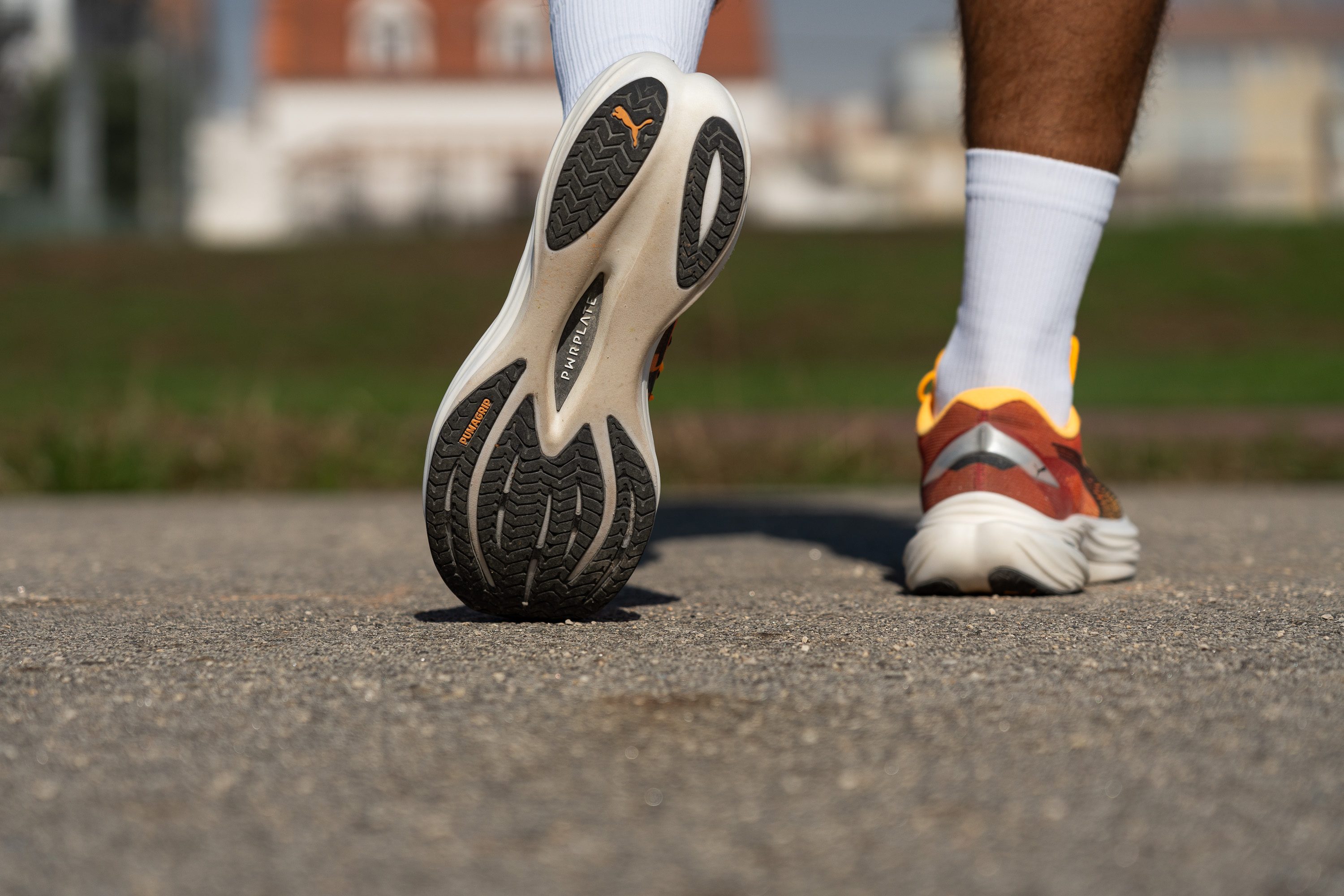
Flexibility / Stiffness
While it still incorporates a carbon plate and delivers a stiff feel, the DN3 it's definitely a gentler ride when compared to the DN2. This modification makes sense for a training shoe, so we fully endorse this adjustment.
In our 30-degree bend test, the Deviate Nitro 3 recorded a force of 20.6N, which confirms its more forgiving nature despite packing a carbon plate.
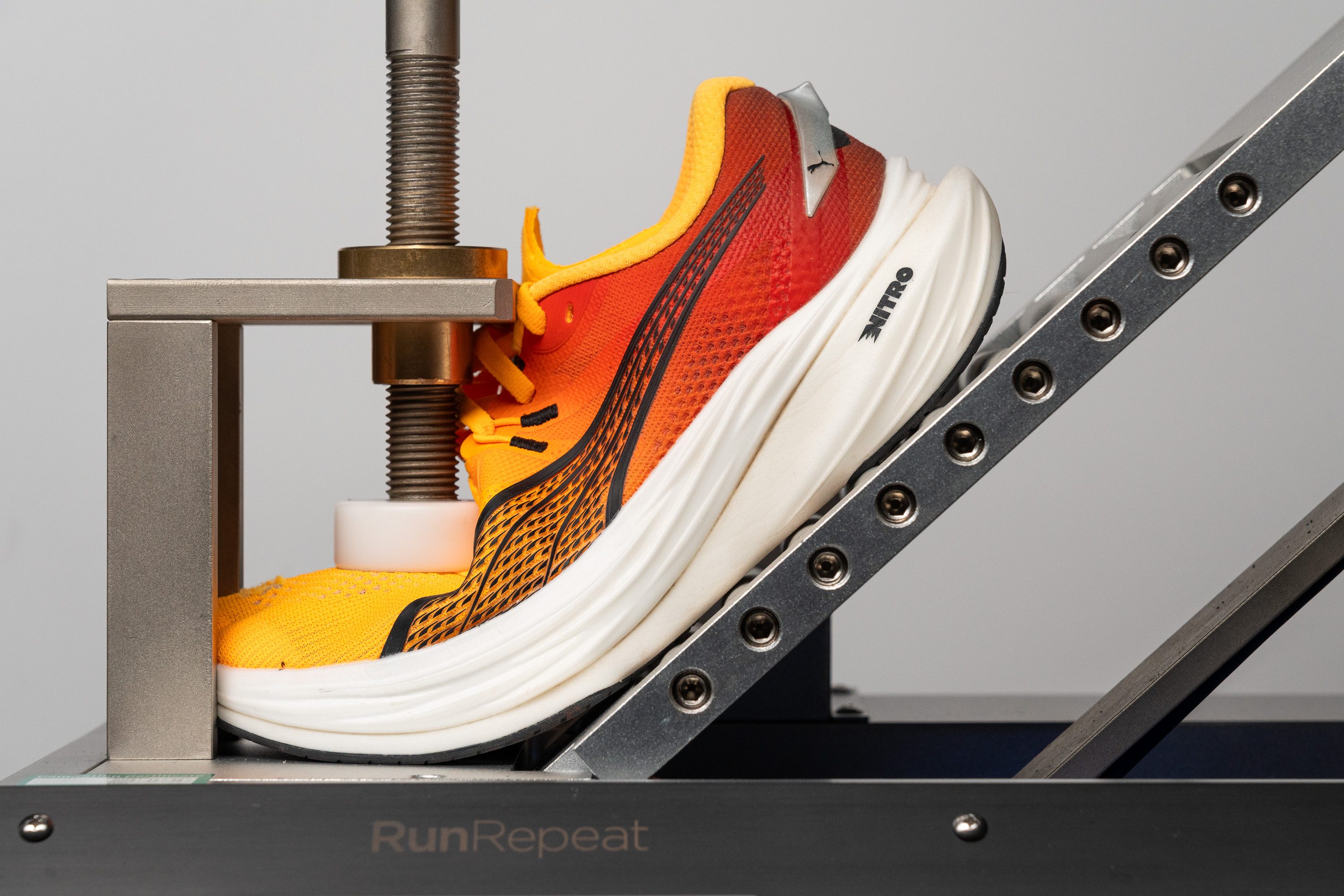
| Deviate Nitro 3 | 20.6N |
| Average | 15.3N |
Weight
Weighing 9.5 oz (268g), we noticed a minor increase of 0.4 oz from its predecessor—likely due to the increased stack height we'll discuss next.
Despite this, the shoe felt light and agile, not cumbersome at all during all of our runs.
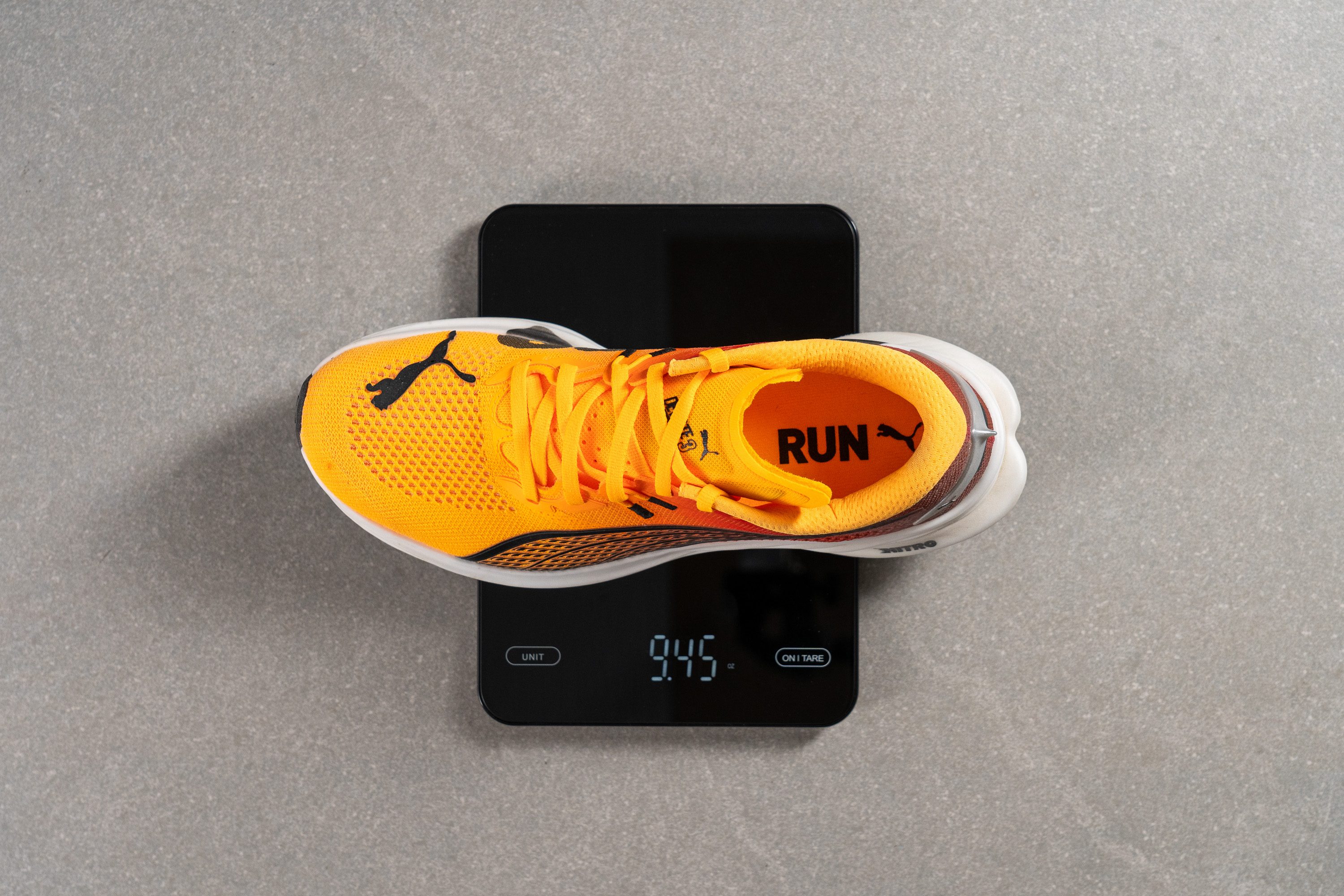
| Deviate Nitro 3 | 9.5 oz (268g) |
| Average | 9.3 oz (264g) |
Breathability
Knit uppers commonly show reduced breathability in our smoke tests, and the Deviate Nitro 3 is no exception. While exceptionally comfortable, its airflow does suffer somewhat.
We assigned this model a 3 out of 5 rating—a respectable score for those planning to use these shoes throughout the year but not in excessively hot conditions, where they might fall short.
Our light test revealed focused ventilation in the toebox area—thankfully, since this is crucial for preventing overheating and a 1/5 score.

Under the microscope, we found a thin structural layer beneath a denser knit—this is typical for knit uppers. We also discovered that instead of incorporating specific ventilation holes, PUMA opted for a highly breathable design throughout the top part of the toebox.
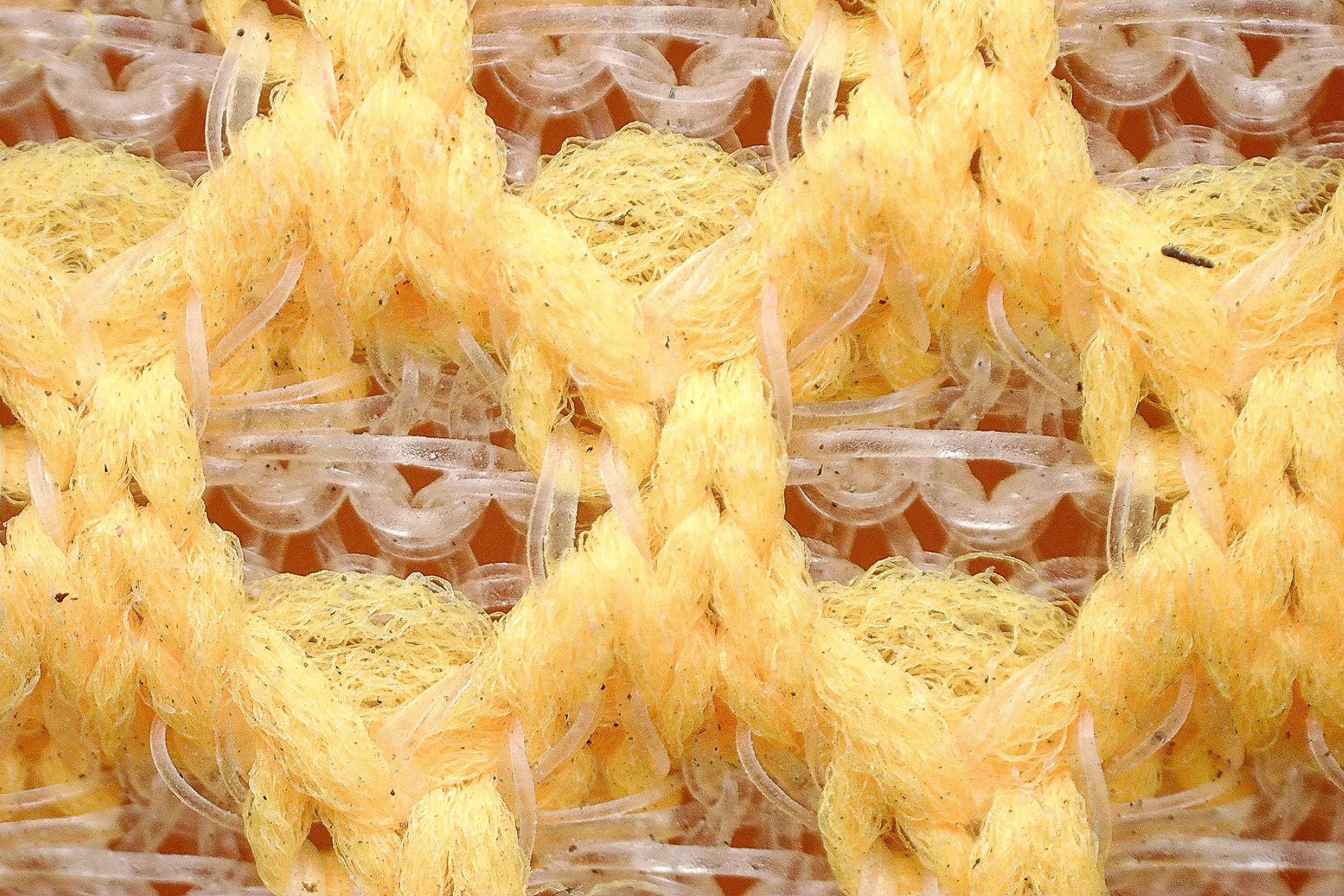
One significant benefit of knit uppers is their ability to stretch and mold to the foot's shape, and the Deviate Nitro 3 excels in this aspect. It really hugged our feet.
Additionally, it incorporates PUMA's PWRTAPE technology, enhancing the upper's durability and adding stability.
| Deviate Nitro 3 | 3 |
| Average | 3.7 |
Stability
Lateral stability test
From our perspective, the Deviate Nitro 3 demands good running form and a neutral footstrike. Otherwise, you'll struggle with stability despite the carbon plate, which helps but cannot overcome the compromises of its narrow and tall design.
Torsional rigidity
The carbon plate nestled between two big foam layers enhances the shoe's torsional rigidity. After manually twisting the shoe with our hands, we awarded it a 4 out of 5 for its stiffness.
| Deviate Nitro 3 | 4 |
| Average | 3.5 |
Heel counter stiffness
We found the heel counter soft and pliable, similar to some competition shoes we've recently tested like the Metaspeed Sky Paris. While it reduces versatility and rear support, we liked the race-day vibe it gives—making you want to go fast and focus on your running form.
| Deviate Nitro 3 | 2 |
| Average | 2.9 |
Midsole width - forefoot
The racing vibes are born with the midsole dimensions, as this is not a wide shoe by any means.
At just 109.3 mm, it sacrifices some stability but offers an agile and swift ride. We believe that neutral runners with pristine technique will particularly love this design.
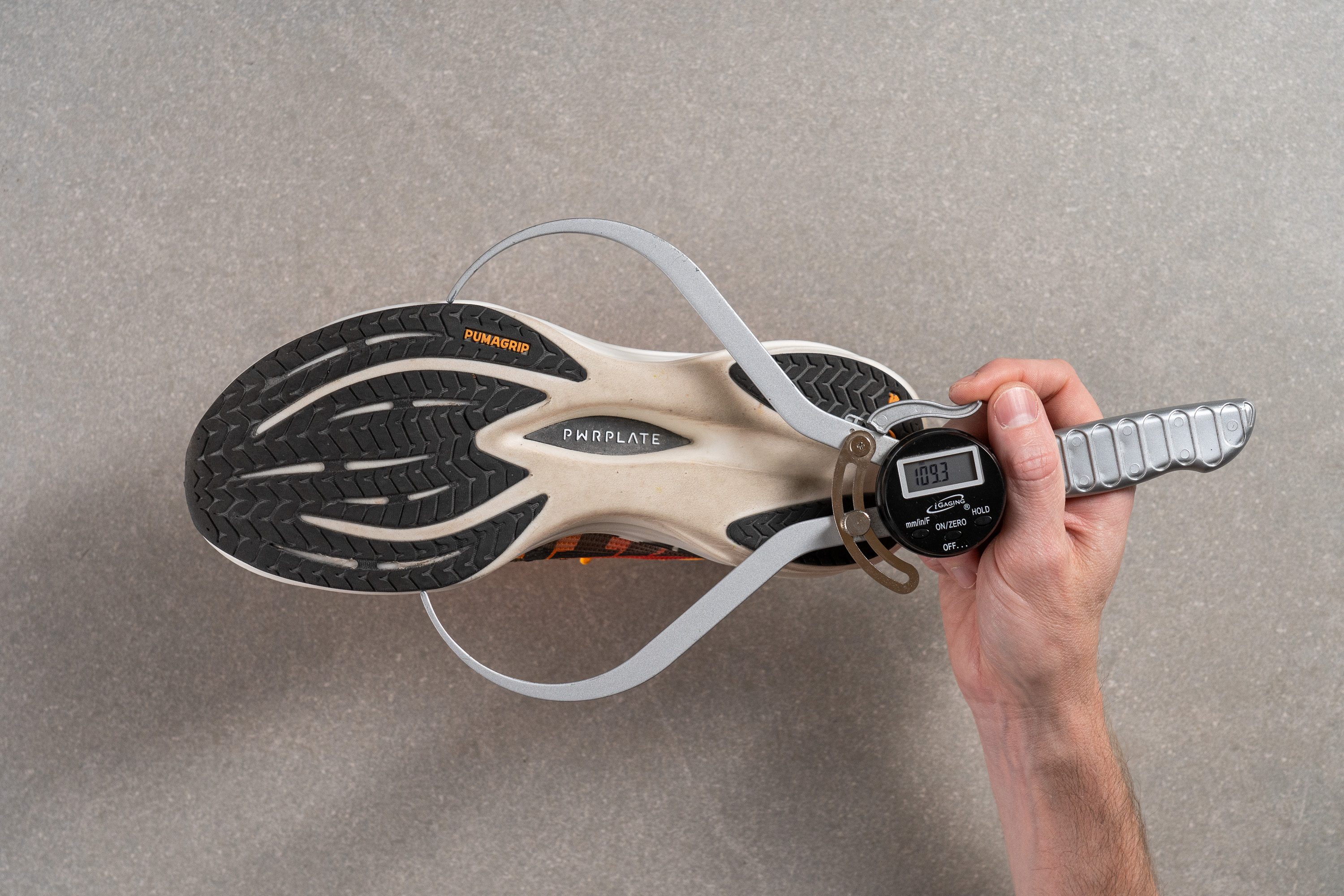
| Deviate Nitro 3 | 109.3 mm |
| Average | 114.4 mm |
Midsole width - heel
The heel narrows even more dramatically to 82.7 mm, far slimmer than typical training shoes. We found this shoe to be a blend of competition (dimensions, plate) and training (weight, upper). While it will work fantastic for some, it’s absolutely not for anyone with stability issues.

| Deviate Nitro 3 | 82.7 mm |
| Average | 90.7 mm |
Plate
PUMA deserves praise for pioneering the integration of a carbon plate into training shoes, effectively creating the supertrainer category.
The third iteration of the Deviate Nitro retains this innovative approach—featuring a carbon plate (PWRPLATE) nestled between two layers of foam. The design maintains a slight curve in the plate, distinguishing it from the more extreme spoon-shaped designs found in racing shoes like the PUMA Fast-R Nitro Elite 2.
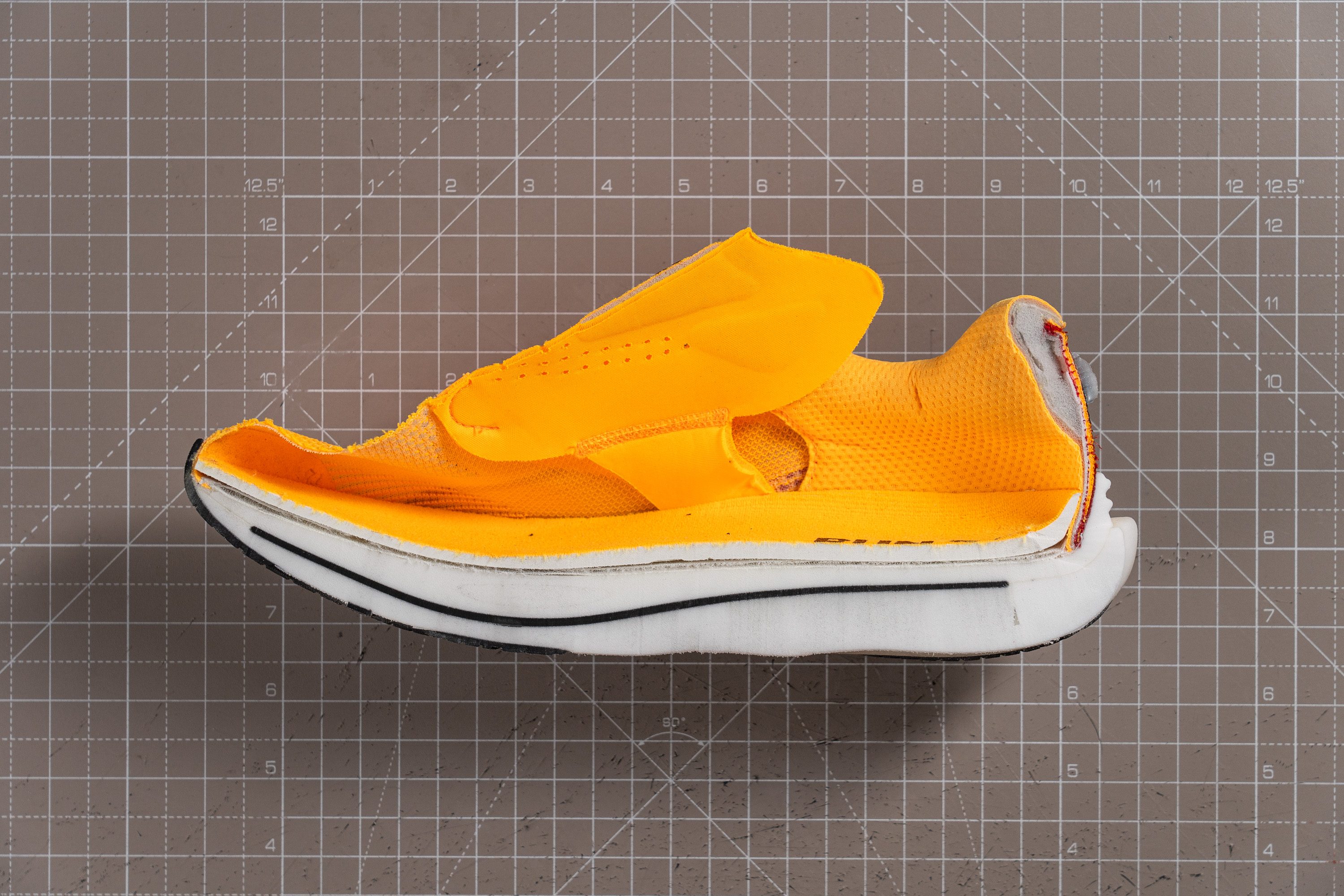
Durability
Toebox durability
Having lab tested hundreds of shoes, we often brace ourselves for low scores with knit uppers—particularly those with abundant ventilation holes. However, PUMA has exceeded our expectations in this area with the Deviate Nitro 3.
And that's because achieving a 3 out of 5 in our Dremel test is a rare feat for an upper like this one. While it's not the highest possible score, it's a fantastic achievement that truly deserves praise from us.
This is possible due to the layer we previously mentioned in the microscopic images. Without this secondary structural mesh, the result would have been a 1/5 for sure.
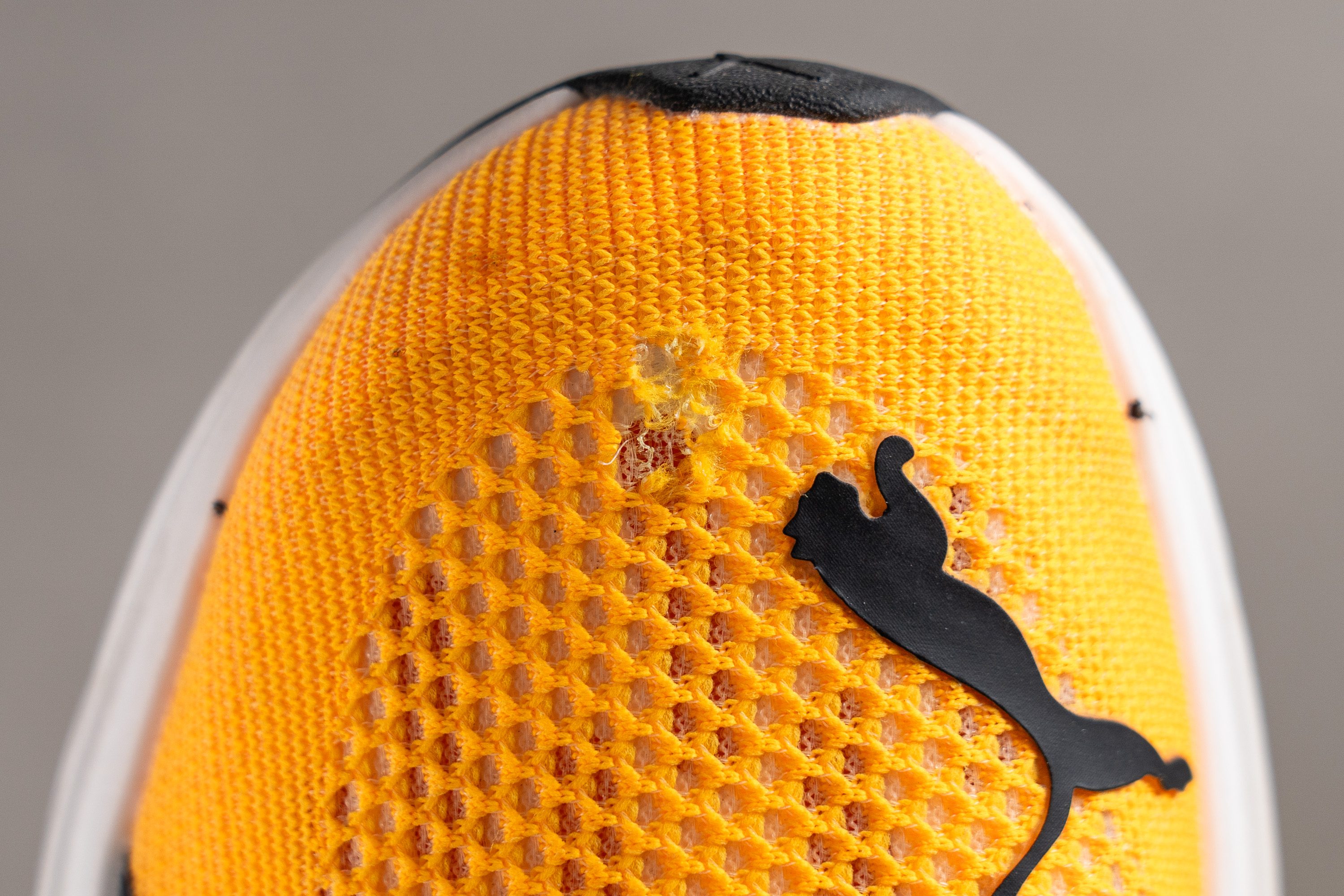
| Deviate Nitro 3 | 3 |
| Average | 2.6 |
Heel padding durability
After being satisfied with the toebox, we shifted our focus to the heel padding of the Deviate Nitro 3.
Although it also scored a 3 out of 5, we feel it didn't quite meet our expectations in this area. While this score isn't alarming and doesn't suggest premature wear for most runners, a rating like 4 or 5 would have left us more pleased.

| Deviate Nitro 3 | 3 |
| Average | 3.4 |
Outsole durability
While testing with the Dremel tool, we noticed the PUMAGRIP ATR rubber did not meet our expectations for durability.
Our test results revealed a concerning 1.5 mm indentation—larger than what we'd expect from top-tier outsoles. This could be concerning for runners who quickly wear down their outsoles, as this shoe's exceptional grip comes at the cost of some durability.
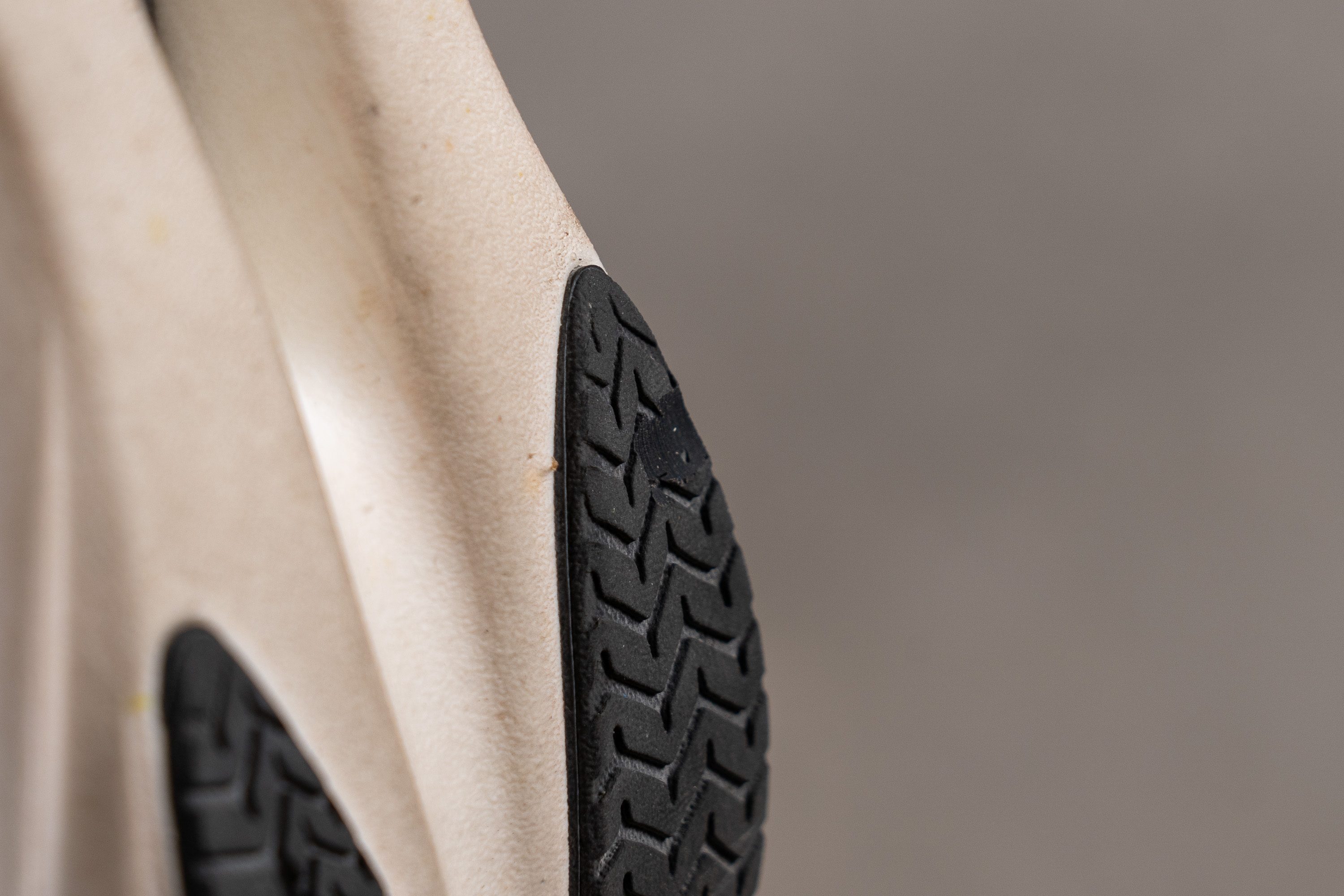
| Deviate Nitro 3 | 1.5 mm |
| Average | 1.1 mm |
Outsole thickness
However, our measurements show that PUMA employed 3.2 mm of rubber in the outsole—a standard strategy that should guarantee at least a decent mileage for this shoe, despite its quicker wear.

| Deviate Nitro 3 | 3.2 mm |
| Average | 3.2 mm |
Misc
Insole thickness
The increase in the insole's thickness to 5.0 mm (up from 4.4 mm) enhanced comfort and slightly contributed to the increased stack height.

| Deviate Nitro 3 | 5.0 mm |
| Average | 4.5 mm |
Removable insole
We found that the insole is removable—as it's not glued down—and offers nothing extraordinary that would stop someone from swapping it out if necessary. It's essentially just a standard sockliner.

| Deviate Nitro 3 | Yes |
Midsole softness in cold (%)
After putting the DN3 in the freezer for 20 minutes, we tested it again with our durometer. The result was a bit disappointing, with a 29.9% increase.
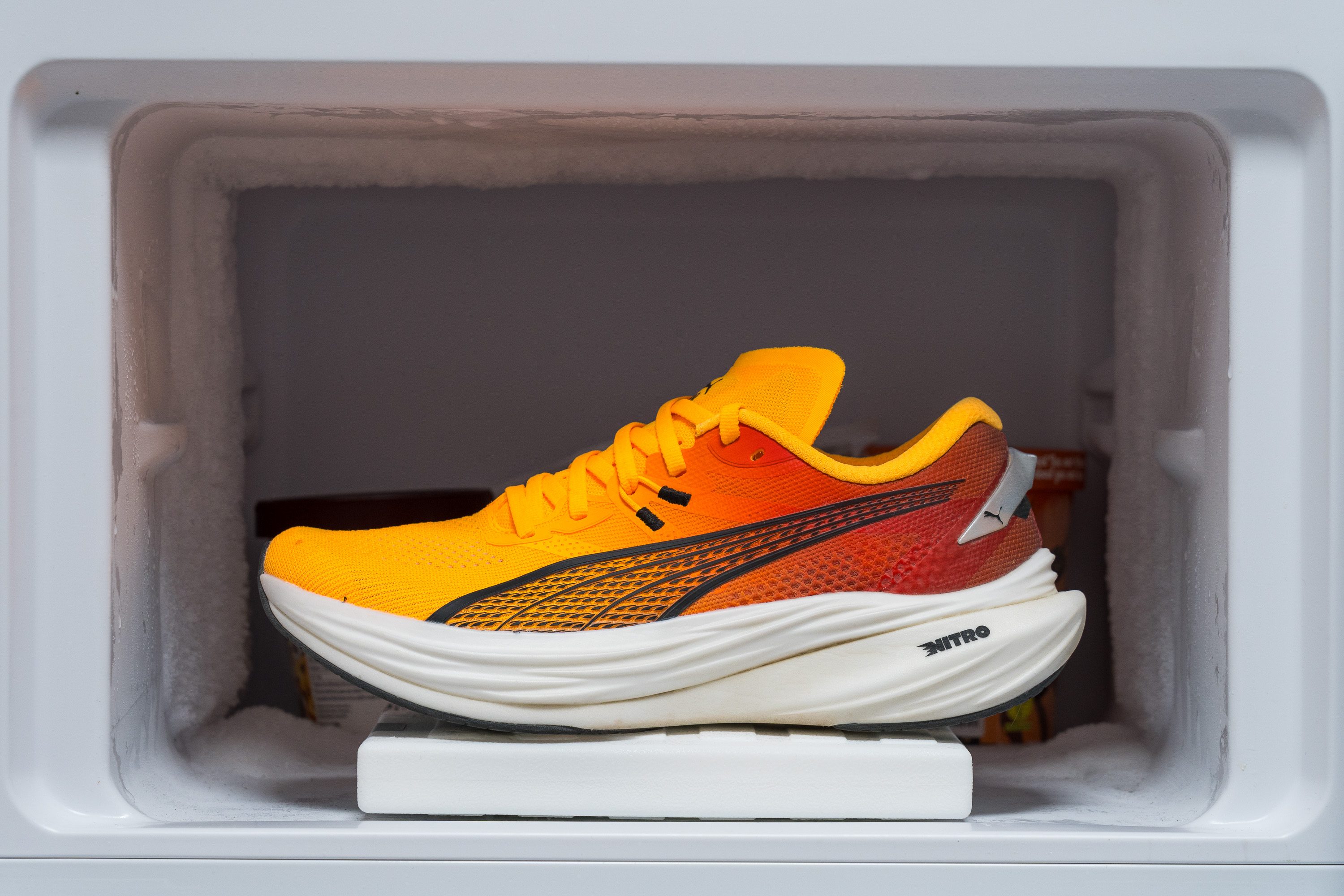
| Deviate Nitro 3 | 30% |
| Average | 24% |
Reflective elements
Unfortunately, PUMA overlooked adding reflective elements to the design of the Deviate Nitro 3. We hope they'll reconsider for future editions—it would be dope if those large NITRO letters were made reflective!
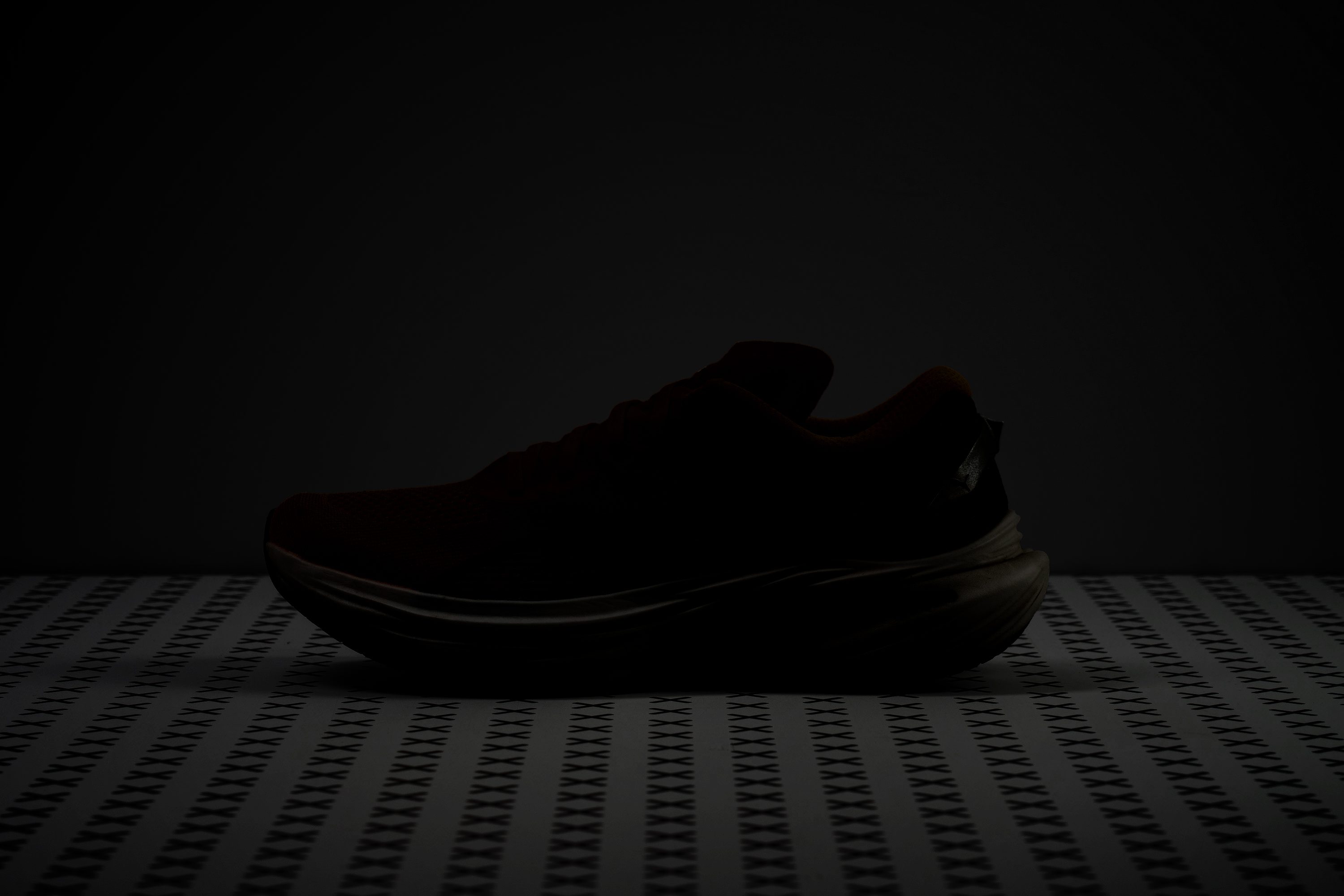
| Deviate Nitro 3 | No |
Tongue padding
The tongue of the DN3, at 4.7 mm thick, offers impressive padding for a lightweight uptempo trainer—we think it's brilliantly designed for this type of shoe.

The tongue sits slightly higher than usual, but it's not a major concern..
We've observed that the padding is smartly placed to minimize weight, focusing the foam where the laces deliver the most pressure and keeping the rest of the tongue exceptionally thin.

| Deviate Nitro 3 | 4.7 mm |
| Average | 5.8 mm |
Tongue: gusset type
In our testing, we found the semi-gusseted design of the tongue—which means that it's partially attached to the shoe's sides—really good.
Why? Well, it prevents sideways movement at faster paces, ensuring a secure fit that is essential for tempo and interval workouts.

| Deviate Nitro 3 | Both sides (semi) |
Heel tab
The Deviate Nitro 3 lacks a heel tab, though we noticed a plastic piece designed for both aesthetic appeal and structural support. We're on the fence about this addition.
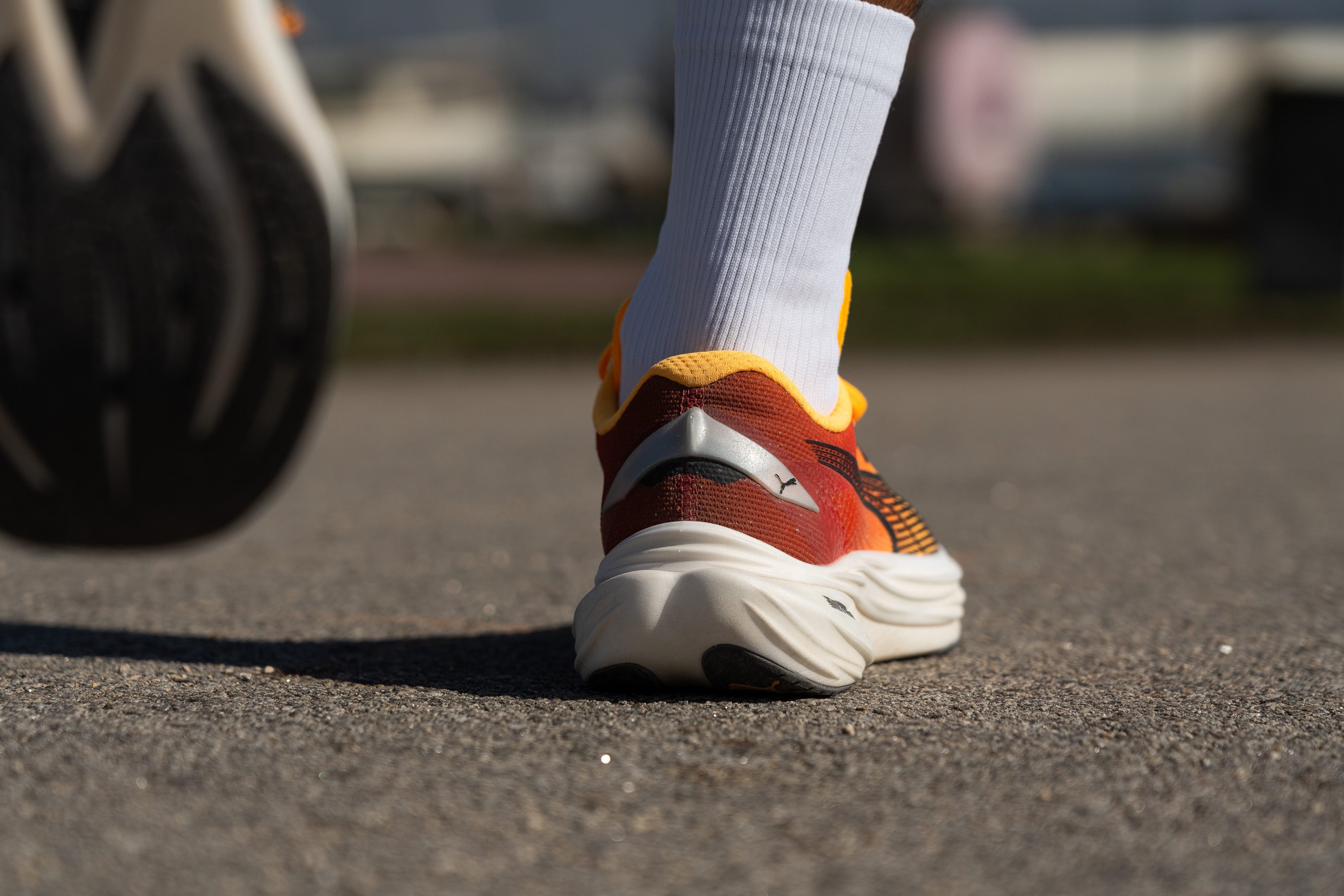
| Deviate Nitro 3 | None |

